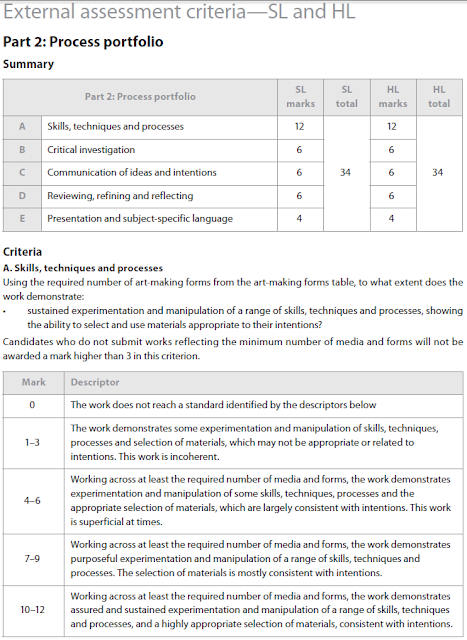Part 2: Process portfolio 40%
EXAMPLES FROM IB: 1, 2, 3
"All students should use their visual arts journal to carry out their explorations with techniques, technologies, effects and processes and to record their discoveries. They should chart and reflect on their experiments with media, their decision-making and formation of artistic intentions. Students will select, adapt and present what they have recorded in their journal as the basis for material submitted for the process portfolio task." Weighting: 40%
Students at SL and HL submit carefully selected materials which demonstrate their experimentation, exploration, manipulation and refinement of a variety of visual arts activities during the two-year course. The work, which may be extracted from their visual arts journal and other sketch books, notebooks, folios and so on, should have led to the creation of both resolved and unresolved works. The selected process portfolio work should show evidence of their technical accomplishment during the visual arts course and an understanding of the use of materials, ideas and practices appropriate to visual communication. They should be carefully selected to match the requirements of the assessment criteria at the highest possible level.
The work selected for submission should show how students have explored and worked with a variety of techniques, effects and processes in order to extend their art-making skills base. This will include focused, experimental, developmental, observational, skill-based, reflective, imaginative and creative experiments which may have led to refined outcomes.
Structuring the process portfolio
Students will have pursued their own interests, ideas and strengths, and their submitted work should highlight the key milestones in this journey. The submission may come from scanned pages, photographs or digital files. The process portfolio screens may take a variety of forms, such as sketches, images, digital drawings, photographs or text. While there is no limit to the number of items students may wish to include on each screen, students should be reminded that overcrowded or illegible materials may result in examiners being unable to interpret and understand their intentions.
The selected screens should evidence a sustained inquiry into the techniques the student has used for making art, the way in which they have experimented, explored, manipulated and refined materials, technologies and techniques and how these have been applied to developing work. Students should show where they have made independent decisions about the choices of media, form and purpose that are appropriate to their intentions. The portfolio should communicate their investigation, development of ideas and artworks and evidence a synthesis of ideas and media. This process will have inevitably resulted in both resolved and unresolved artworks and candidates should consider their successes and failures as equally valuable learning experiences.
Examiners are looking to reward evidence of the following:
- sustained experimentation and manipulation of a variety of media and techniques and an ability to select art-making materials and media appropriate to stated intentions
- sustained working that has been informed by critical investigation of artists, artworks and artistic genres and evidence of how these have influenced and impacted own practice
- how initial ideas and intentions have been formed and how connections have been made between skills, chosen media and ideas
- how ideas, skills, processes and techniques are reviewed and refined along with reflection on the acquisition of skills and analysis of development as a visual artist
- how the submitted screens are clearly and coherently presented with competent and consistent use of appropriate subject-specific language.
Students must ensure that their work makes effective use of appropriate subject-specific language.
Art-making forms
For SL students the submitted work must be in at least two art-making forms, each from separate columns of the table below. For HL students the submitted work must have been created in at least three art-making forms, selected from a minimum of two columns of the art-making forms table below. The examples given are for guidance only and are not intended to represent a definitive list.
Submitted work might well include experiments undertaken during (and reflections upon) taster sessions in particular media, demonstrations of techniques, workshops, master classes, guided experimentation and studio practice experienced as part of the core syllabus activities outlined above.
Formal requirements of the task—HL HL students submit 13–25 screens which evidence their sustained experimentation, exploration, manipulation and refinement of a variety of art-making activities. For HL students the submitted work must have been created in at least three art-making forms, selected from a minimum of two columns of the art-making forms table.
Submitting assessment work
The submitted screens must not include any resolved works submitted for part 3: exhibition assessment task.
The size and format of screens submitted for assessment is not prescribed. Submitted materials are assessed on screen and students must ensure that their work is clear and legible when presented in a digital, on-screen format. Students should not scan multiple pages of work from their journals and submit them as a single screen, for example, as overcrowded or illegible materials may result in examiners being unable to interpret and understand the intentions of the work. The procedure for submitting work for assessment can be found in the Handbook of procedures for the Diploma Programme. Students are required to indicate the number of screens when the materials are submitted. Where submitted materials exceed the prescribed screen limits examiners are instructed to base their assessment solely on the materials that appear within the limits.





No comments:
Post a Comment